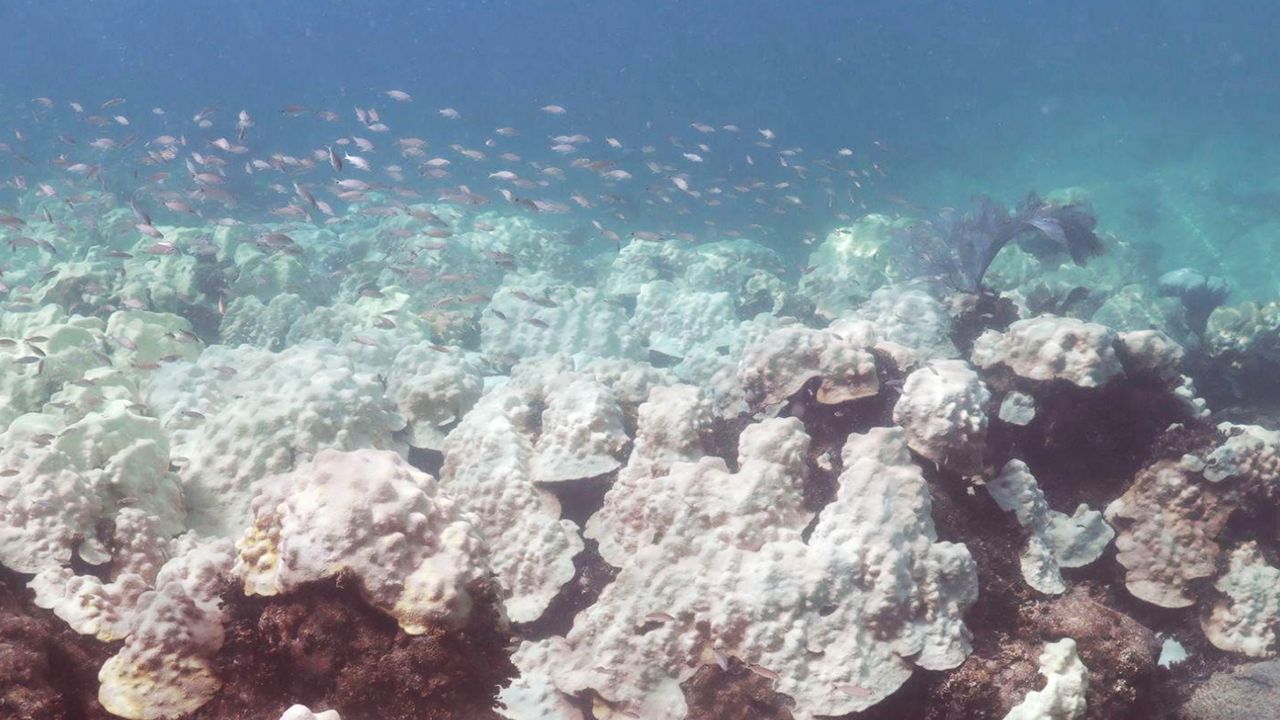Coral reefs are feeling the effects of extremely warm ocean temperatures.
What is coral bleaching?
Coral bleaching occurs when the coral becomes stressed by changes in the environment.
The symbiotic algae living in the coral leaves, turning the coral white. It’s the algae that gives coral its color.
Coral can survive coral bleaching, but they are more susceptible to dying. Some coral can die in as little as two weeks, and others it can take a couple of months.
Even if some coral survive these events, they can still feel long-lasting effects, becoming sterile for years and more susceptible to diseases.
How does it affect the environment?
Coral reefs are great at buffering coastlines from storms and erosion.
They provide habitats for many ocean wildlife, and they help support local economies by providing jobs and tourism.
Without them, this all goes away.
What we’re seeing
In this case, ocean waters are too warm, which is stressing coral reefs.
And according to the National Oceanic and Atmospheric Administration (NOAA), the heat stress is affecting all of Florida’s coral reefs and has “developed earlier than ever before by five to six weeks.”
Southeast Florida is under an Alert Level 2, which means severe bleaching and significant mortality is likely, which has never happened.
Some soft corals have already died.
And Derek Manzello, coordinator for the NOAA Coral Reef Watch Program, says “the heat stress is not expected to dissipate until mid-to-late September or early October. This means we may be looking at an additional month of heat stress in Florida.”
He also says that tropical systems could change this as they can redistribute temperatures in the ocean and help cool the water around the coral. However, the Atlantic has not become very active yet this season. But if we do see activity, these predictions can change.
What is being done to help coral reefs?
NOAA’S Office of Habitat Conservation, Florida Keys National Marine Sanctuary and other partners are working together to help restore the Florida Reef Track.
Andy Bruckner, a research coordinator for NOAA’s Florida Keys National Marine Sanctuary, says that NOAA has worked with restoration partners to relocate thousands of coral from shallow water nurseries.
They have made genetic rescues of Elkhorn coral and Staghorn coral fragments, taking every remaining unique genotype known to exist in the reefs of Florida and moving them to Mote Aquaculture Research Park and The Reef Institute for gene banking.
He also notes that scientists will not relocate every coral from shallow water nurseries. They study the coral in the shallow waters to better understand how they perform under periods of high temperature.
Research crews will evaluate patterns of recovery to identify sites that are more or less resilient to temperature stress. They hope to identify coral that resisted bleaching with the intent of using these coral in future restoration efforts.

A shading nursery structure. (NOAA)
They are also conducting other experiments such as moving coral to cooler waters until the areas in shallow water cool down. They are providing shading for coral and conducting predator control to minimize stress.
Scientists are working hard to help restore our coral reefs, but it’s going to take a long time until we see improvement.
Our team of meteorologists dives deep into the science of weather and breaks down timely weather data and information. To view more weather and climate stories, check out our weather blogs section.

